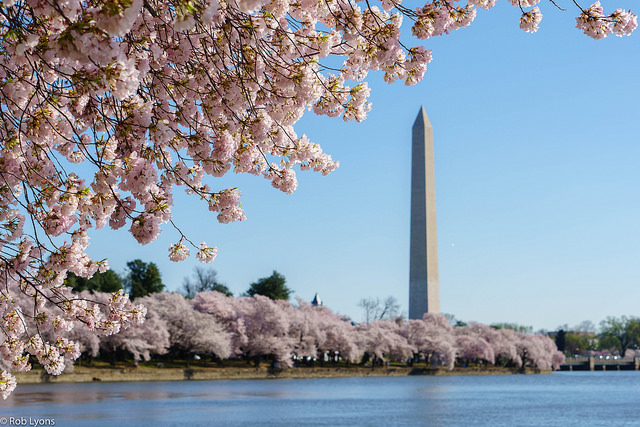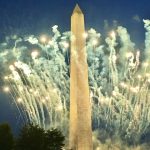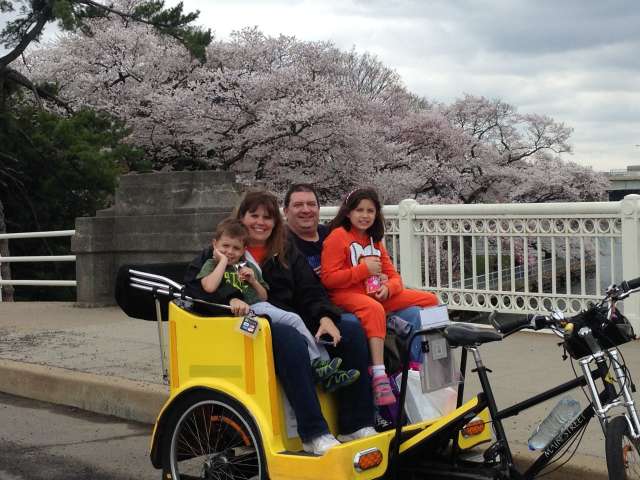Cherry Blossom Tours
There are many kinds of cherry blossom tours available. But the best way to visit the Cherry Blossoms is to go on a pedicab tour. Nonpartisan Pedicab offers tours of the National Mall and the monuments and memorials. We can take you around the Tidal Basin to see the Cherry Blossoms surrounding the Jefferson Memorial, the FDR Memorial and the MLK Memorial. We can also take you down to Haines Point to see even more cherry blossoms.
The trees blossom in late March or early April depending on various factors such as the temperatures and precipitation of the winter. The trees are in pre-bloom for a couple of days. Then, they go into full bloom for just a few days. There are a few stands of a more hardy variety of blossom that last for as long as two weeks. Hopefully, your trip will occur when the trees are in full bloom.
The largest grouping of cherry trees is around the Tidal Basin. This is also where you will find several major monuments such as the Thomas Jefferson Memorial, the Franklin D. Roosevelt Memorial, and the Martin Luther King, Jr. Memorial. On Nonpartisan Pedicab cherry blossom tours you will get a chance to stop at each of these monuments and walk in to look around and take pictures.
The cherry blossoms will be celebrating 103 years in 2015. The original cherry trees were a gift from Japan. The first lady of the United States, First Lady Helen Herron Taft and Viscountess Chinda, wife of the Japanese ambassador, planted the first two of these trees on the north bank of the Tidal Basin in West Potomac Park. At the end of the ceremony, the First Lady presented Viscountess Chinda with a bouquet of ‘American Beauty’ roses. These two trees still stand at the terminus of 17th Street Southwest, marked by a large plaque. By 1915, the United States government had responded with a gift of flowering dogwood trees to the people of Japan.
The first “Cherry Blossom Festival” was held in 1935 under joint sponsorship by numerous civic groups, becoming an annual event. The cherry trees had by this point become an established part of the nation’s capital. In 1938, plans to cut down trees to clear ground for the Jefferson Memorial prompted a group of women to chain themselves together at the site in protest. A compromise was reached where more trees would be planted along the south side of the Basin to frame the Memorial. A Cherry Blossom Pageant was begun in 1940.
On December 11, 1941, four trees were cut down. It is suspected that this was retaliation for the attack on Pearl Harbor by the Empire of Japanfour days earlier, though this was never confirmed. In hopes of dissuading people from further attacks upon the trees during the war, they were referred to as “Oriental” flowering cherry trees for the war’s duration. Suspended during World War II, the festival resumed in 1947 with the support of the Washington, D.C., Board of Trade and the D.C. Commissioners.
In 1948, the Cherry Blossom Princess and U.S. Cherry Blossom Queen program were started by the National Conference of State Societies. A Princess was selected from each state and federal territory, with a queen chosen to reign over the festival. In 1952, Japan requested help restoring the cherry tree grove at Adachi, Tokyo along the Arakawa River, which was the parent stock of the D.C. trees but had diminished during the war. In response, the National Park Service sent budwood back to Tokyo.
The Japanese ambassador gave a 300-year old stone lantern to the city of Washington to commemorate the signing of the 1854 Japan-US Treaty of Amity and Friendship by Commodore Matthew C. Perry. For a number of years, the lighting of this lantern formally opened the Festival. Three years later, the president of the pearl company started by Mikimoto Kōkichi donated the Mikimoto Pearl Crown. Containing more than five pounds of gold and 1,585 pearls, the crown is used at the coronation of the Festival Queen at the Grand Ball. The next year, the Mayor of Yokohama gifted a stone pagoda to the City to “symbolize the spirit of friendship between the United States of America manifested in the Treaty of Peace, Amity and Commerce signed at Yokohama on March 31, 1854.”
The Japanese gave 3,800 more Yoshino trees in 1965, which were accepted by First Lady Lady Bird Johnson. These trees were grown in the United States and many were planted on the grounds of the Washington Monument. For the occasion, the First Lady and Ryuji Takeuchi, wife of the Japanese ambassador, reenacted the 1912 planting. In 1982, Japanese horticulturalists took cuttings from Yoshino trees in Washington, D.C., to replace cherry trees that had been destroyed in a flood in Japan. From 1986 to 1988, 676 cherry trees were planted using $101,000 in private funds donated to the National Park Service to restore the trees to the number at the time of the original gift.
In 1994, the Festival was expanded to two weeks to accommodate the many activities that happen during the trees’ blooming. Two years later, the Potomac and Arakawa became sister rivers. Cuttings were taken from the documented 1912 trees in 1997 to be used in replacement plantings and thus preserve the genetic heritage of the grove. In 1999, fifty trees of the Usuzumi variety from Motosu, Gifu, were planted in West Potomac Park. According to legend, these trees were first planted by Emperor Keitai in the 6th century and were designated a National Treasure of Japan in 1922. From 2002 to 2006, 400 trees propagated from the surviving 1912 trees were planted to ensure the genetic heritage of the original donation is maintained.






